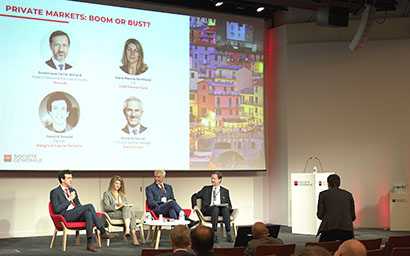Private markets investment has enjoyed a boom period, but market and macroeconomic trends are reversing. Panellists at the Societe Generale Securities Services (SGSS) European Investor Summit anticipated more caution in the near-future.
Private markets investments have become more important for investors since the financial crisis caused structural changes in the way the economy was financed. These changes led to high-yielding assets such as private equity gaining appeal as interest rates and inflation dropped to unprecedented low levels.
The question today, in a much more inflationary environment, with market and macroeconomic trends reversing, is whether these investments can maintain their appeal.
These issues were explored in depth at the ‘Private Markets: Boom or Bust?’ panel at SGSS’s European Investor Summit, held in Paris on June 8.
“Private markets have been one of the biggest winners of the last decade, with low interest rates as one of the main drivers,” said Yannick Oswald, partner at Mangrove Capital Partners. “2022 seems like a new era. After two long Covid years, uncertainty continues to define the world, but for very different, albeit straightforward reasons.
“Conflict in Eastern Europe, rising inflation and supply-side constraints are all causing uncertainty, which is driving volatility. As a result, we have seen the Nasdaq fall 30% since January.”
A poll taken at the conference showed that 60% of attendees felt uncertainty to be higher than two years ago, when Covid-19 was raging and lockdowns were being enforced across many countries.
Against this backdrop, market participants are concerned over valuations. There have been price adjustments, but they have not been uniformly distributed across asset classes, whether that be private equity, real estate or private debt.
Corrections
The lifecycle of a portfolio company is a factor. Prices appear to remain higher at the early stages of a company’s life, until corrections occur at a later date when the company is close to an initial public offering.
“One of the problems is that private markets are private, and it is always hard to access the holistic data,” said Dominique Carrel-Billiard, head of real and alternative assets at the asset manager Amundi.
“There are things that we know for sure, and then feelings that we can develop through the windows we have on the markets. What we do know is that 2021 was banner year, with $1.2 trillion of new money flowing into private markets. It is too early to tell the impact of the correction, but it will depend on the asset class.”
He pointed to private debt where market conditions in public debt are taking their toll. “They are the canary in the coal mine and we are seeing spreads widening and rates increasing. The good news is that since you mostly have floating rate instruments in private debt, there is no duration risk. The most important thing to look at in these investments is the credit quality.”
Riccardo Serrini, chief executive officer at Prelios Group, an Italian leading alternative asset manager, agreed, and flagged the growing popularity of unlikely-to-pay (UTP) bank loans. Falling under the distressed debt umbrella, these are sub-performing loans; they are not yet in default and can be recovered by restoring borrowers to health. However, they require more complex and specialised skills to manage and evaluate.
The Italian non-performing-exposure (NPE) market overall remains the largest and, Serrini believes, one of the most promising. “This is because the market is fully decorrelated to bonds and equities as well as being anti cyclical,” he said.
“We expect the growth trend to continue in our business based on deleveraging programme from the banking system. Italian banks have done a strong deleveraging plan starting in 2015, when the gross amount of non-performing exposure peaked at €340 billion. By the end of last year, the NPE stood at €78 billion, of which €45 billion was UTPs.”
The real estate buffer
Looking beyond credit, real estate can also offer protection, according to Carrel-Billiard. “It behaves differently, and we have enjoyed a significant risk premium when you compare the yield you get on properties compared to the yield on public bonds. That effectively provides a buffer, which has meant that the first increases in rates and spreads have not completely transferred over to real estate prices. You just compress your risk premium and this is the stage where we are.”
He is beginning to see some repricing in real estate, although “it took at least 50 basis points” to trigger a move. The same can be said for private equity in the SME space. “The multiples of the EBITDA for the SME companies we look at are ten to 11 times, and while it will probably decrease with rising rates, it has not happened yet.”
Private equity investors may, for now, be sitting on the sidelines and keeping their powder dry. They will be treading carefully, searching for pockets of opportunities.
“It is a matter of relative value and from that perspective, you have to assess what category of assets you want to be invested in,” said Carrel-Billiard. “I think real assets provide a good risk relative to return – especially when you compare them to public bonds.”
Read our full report from the SGSS European Investor Summit here.
© 2022 funds europe





